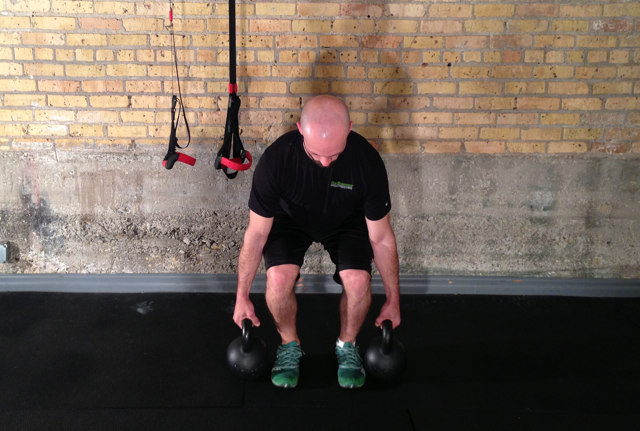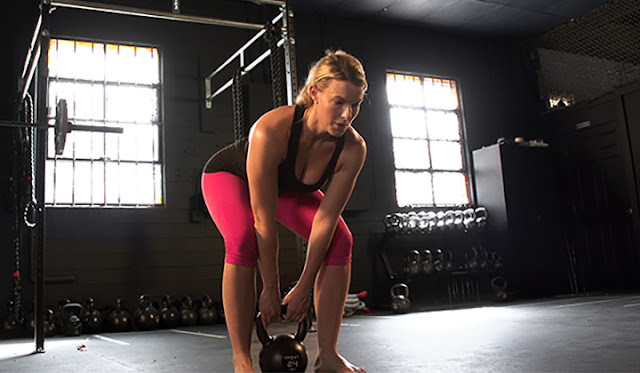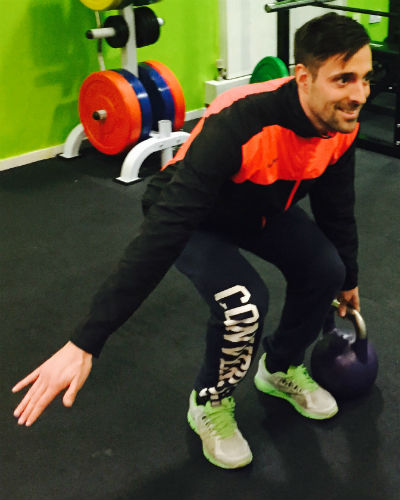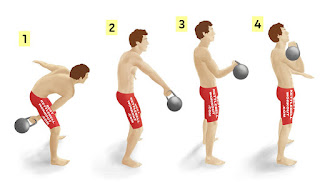The TGU, From Floor to Standing
Step 1
Lie on your side and pull the weight tight. From there, roll
to your back and press the weight up with one arm to a full and locked-out
elbow. That elbow shouldn't bend until the weight hits the floor again.
This position can provide a couple of challenges to lifters
who've had previous shoulder injuries. Doing a simple screwdriver from your
back is a great way to work on shoulder control if you're not ready to progress
further. (The shoulder rotates in its socket through a full of a range of
motion as you try to control the bell.)
Step 2
If you're holding the bell with your left arm, the foot of
your left leg should be flat on the floor with bent knee. The other leg should
be positioned straight out. You'll now need to roll over onto your free elbow
and pull yourself up, but with an arm raised and a weight over your head.
A lot of people try to make this a rotating sit-up by using
their abs to do most of the work. They end up kicking up that stretched-out leg
and flailing around. Instead of doing something that's incredibly hard and
makes you look like a tool, try a simpler version.
Use that flat foot on the ground and press it
down, which causes your hips to roll over in the direction from which you
initially picked the bell off the floor. Make sure the bell stays vertical over
your shoulder.
This hip roll move should involve minimal spinal motion.
Instead, focus on getting strong glute extension on one side to help roll and
propel you up onto your elbow. This position will be short lived, however, as
you triceps press yourself up so that palm is flat on the ground.
The one-sided hip extension roll can be used for reps with
people who have some sleepy glutes or who have a bit of a cranky low back and
need to spend some time working on stabilizing their spine under hip extension.
The torso is supported on the ground, there's little
compressive or shear forces as long as you're driving the work from the glutes,
and the core has to brace to allow a transfer of force from the hips through
the shoulder.
Step 3
This is where the wheels typically fall off for most people.
If the first two steps were basic math, the third is apparently calculus. You
either get it or you don't.
Keeping the bell straight up, the foot flat, and the palm on
the ground, transfer your weight to your hand and lift your hips off the
ground. Your hips could lift as little as 3 inches or you could be a show-off
and lift them 3 feet if you feel like it. It doesn't matter; just lift your
hips.
Once you've done that, bring your knee back in line with the
hand and foot that are on the ground, while the other foot slides back and
points in the general direction of your flat foot. This winds up giving you a
base of support that involves your hand, knee, opposing foot, and a cheering
audience marveling at your awesomeness.
Make sure your shoulders aren't rolled forward during this
side bent position. Forward rolled shoulders mean you're pretty much relying on
your biceps tendons to hold your shoulder together, so try to think about
pulling the shoulders back and into their respective sockets. This will make
bearing the load of the bell much easier.
Once in a stable side bent position, shift your weight over
your hips so that you can lift your hand off the floor. This half kneeling
position with a weight overhead is a fun adventure for anyone with a lateral
instability and it's a big challenge for folks who have hip, back, or thoracic
issues. It's going to make your instability really apparent.
Step 4
This is the least complex step, but it's also the hardest.
With your core and hips braced hard, press up into a standing position and
bring your feet together so you look like the Statue of Liberty instead of a
jacked bro holding a weight. Revel in your awesomeness.
Step 5
Congratulations, you just stood up. Now you have to get back
down to the floor without dropping the weight on your face. It's hard enough
for meatheads to meet people, so don't make it harder by having a caved-in
face. Just follow the steps in reverse, which is infinitely easier than trying
to recite the alphabet backwards.
Oh, and don't forget to practice it on the other side, too,
unless you just want to be unilaterally awesome.
If you wanna find a cheap kettlebell but good quality. You can go here to check out: http://yes4all.com/sports-outdoors/kettlebells.html
Yes4All is having an extreme sale off at Friday - sale up to 80% - so what are you waiting for ?































